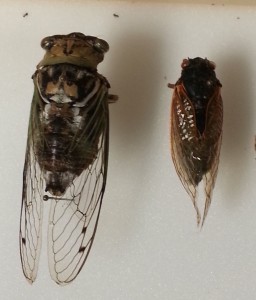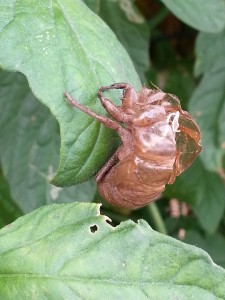 |
June 2015 Newsletter |
Cicadas
Cicadas are fairly large insects but can vary in size with some growing over 1 ½ inches. Color may also vary depending upon species, but many are brown or green. All cicadas have bulging eyes and, on adults, wings that are held roof-like over the body. The wings are semi-transparent with thick wing veins. The majority of their life cycle is spent underground.

Cicadas have 2-5 year life cycles and appear in Texas in mid to late summer. Females insert egg clusters into branches of trees using their saw-like ovipositor (egg laying structure). Eggs hatch after about 6 weeks and small nymphs drop to the ground where they burrow into the soil. Nymphs feed on sap of tree roots with their piercing-sucking mouthparts. After becoming fully developed, nymphs emerge from the ground at night and climb onto nearby objects such as tree trunk, plants, fences, etc. Adult cicadas emerge from the last nymphal stage leaving behind the exuviae (cast skin). Adults can live 5-6 weeks.
Male cicadas are well known for their “song”. They rest on a tree and produce a whining sound to attract females. The sound is produced by two vibrating membranes on the side of the abdomen. Females do not “sing”. Adults feed on juices from tender twigs, but usually do not cause lasting harm to the plant from feeding.
For more information or help with identification, contact Wizzie Brown, Texas AgriLife Extension Service Program Specialist at 512.854.9600. Check out my blog at www.urban-ipm.blogspot.com

